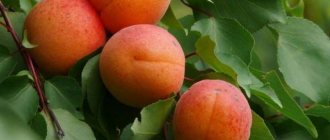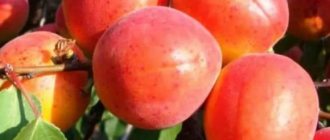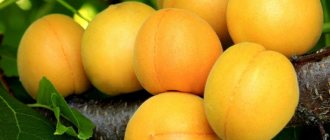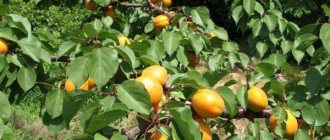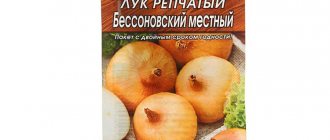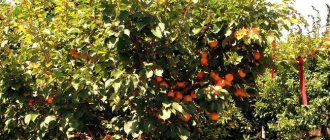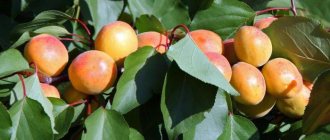Types and popular varieties
In addition to aprium, there are several more hybrids obtained by crossing plum and apricot.
Other hybrid forms:
- Plumcat. Aprium has 75% of the characteristics of apricot, 25% of plum. In plumcotte it’s the other way around – 75% plum, 25% apricot.
- Sharafuga. This hybrid was obtained by crossing apricot, plum and peach.
Breeders have developed many interesting varieties of aprium, differing in ripening time, taste, color and size of the fruit.
The most famous varieties:
- Triumph. Late ripening variety. The golden skin, slightly velvety, has many purple dots.
- Crown. Mid-season variety with yellowish fruits.
- Hummingbird. A medium-ripening hybrid with large sweet and sour fruits.
- Valentin. High-yielding hybrid with sweet fruits, orange or yellow.
- Alex. An early ripening variety with smooth pinkish-crimson fruits. The pulp is dense and yellow.
Diseases and pests of Apricot plum
Plum is affected by diseases that are inherent in all stone fruit crops: cherries, apricots, cherries, and peaches.
Apricot plum can develop black nodule, ovular spotting, and scab. The trunk and branches are affected by the false polypore and the red plum polypore, flat, sulfur-yellow.
On the leaves you can see a saprotrophic fungus, a multihost fungus. The plum suffers from a milky sheen and penicillium rot of the fruit. Timely inspection and detection of diseases will allow you to deal with them in time and prevent the death of fruit trees.
Pests include aphids, codling moths, and leaf rollers.
Main characteristics
Taking the best features of two fruit forms, aprium acquired excellent agrotechnical and taste characteristics.
Tree
Aprium is a fast-growing crop. External signs depend on the variety.
Short description:
- the tree is not tall - about 2-2.5 m;
- crown – thick, rounded;
- leaves – small, green, oblong;
- The flowers are white, with five petals.
Fruits and yield
Popularly, apriums are often called “bald apricots” or “apricot nectarine.” They look like apricots, but without the characteristic rough skin. In aprums it is smooth like a plum.
Aprium fruits are large, spherical. Their characteristics depend on the variety. They may differ in color, taste, weight, and other properties.
Fruit characteristics:
- maximum weight – 70 g;
- average weight – 40 g;
- the skin is smooth, thin, with a slight waxy coating, sometimes there is slight pubescence;
- color – purple, pink, yellow, orange, dark purple, burgundy, greenish.
The taste may be dominated by both apricot and plum notes. The former look more like plums, the latter - apricots. The pulp of aprium is dense and differs from apricots in less juiciness. The fruits often have an orange aftertaste.
The first fruits on the tree appear no earlier than the third year of life. As it grows, harvest volumes increase. 30-40 kg of ripe fruits are collected from one mature tree.
Frost resistance and disease resistance
Aprium compares favorably with heat-loving apricots due to its high winter hardiness. This hybrid can easily withstand temperatures down to –35 °C. The tree can get damaged during a thaw in winter.
The culture, like any hybrid, has excellent characteristics, and disease resistance is no exception. Aprium has excellent immunity, successfully resisting both various types of infections and insect pests.
Late varieties
Cherry Cherry Granite
Cherry plum Granite belongs to the group of mid-late and self-fertile plants. This is a hybrid obtained by Crimean breeders by cross-pollinating the Ashtarak cherry plum and the American plum Seedling Vaneta. Granite has been known to gardeners since 1986. The variety is suitable for cultivation in the North Caucasus and southern regions of Russia.
The trees are tall - up to 5-6 meters, the crown is not very lush, round in shape. The flowers are white, bloom in April, the fruits are oval-shaped, not large in size, their weight is about 25 grams.
The skin is burgundy or dark red, with a waxy coating, dense, and difficult to separate from the pulp. The pulp is rich yellow, juicy, tasty, sweet and sour.
Early fruiting is at an average level, fruits appear from 3-4 years, as a rule, ripen in late August or early September. An adult tree bears up to 80 kg of fruits, which are universally used. They are used fresh or processed.
The variety attracts with its frost resistance down to -30 degrees, resistance to drought, pests and diseases. Fruits damaged by the codling moth are very rare. Diseases also do not cause any harm to the tree.
Advantages and disadvantages
Like any hybrid crop, aprium was created to produce a tree that is superior to its parents in all respects. That is why aprium has much more advantages than disadvantages.
pros
high yield
excellent taste
unpretentiousness and low maintenance requirements
high frost resistance - the hybrid is grown in regions where severe frosts are observed in winter
high immunity
Minuses
The fruits contain too much sugar, so they are not recommended for certain diseases, such as diabetes
Reviews from gardeners
Most often, gardeners are satisfied with these fruit trees purchased and planted on the site. Reviews indicate high winter hardiness and unpretentiousness of hybrid varieties. The taste of the fruits that were obtained several years after planting is also positively assessed.
There are also negative reviews, mainly related to the taste of the crop or its small quantity. Hybrid varieties are still popular and in demand. It is not difficult to grow a mixture of apricot and plum: they care for hybrid seedlings in almost the same way as traditional fruit crops. With proper care, trees will definitely reward the gardener with delicious fruits.
Landing Features
Aprium prefers areas well lit by the sun and protected from blowing winds. The soil for planting is well drained, the acidity reaction is neutral.
When the soil is highly acidified, quicklime is added - “fluff”. Norm – 400 g per 1 sq. m.
It is recommended to purchase seedlings only from specialized nurseries, otherwise the chances of obtaining a varietal hybrid are very scanty.
When choosing a seedling, pay attention to the condition of its bark and roots; they should be healthy, not withered, and without damage.
Aprium planting process:
- Prepare a planting hole 2-3 weeks before planting. If you prefer to carry out planting work in the spring, prepare the holes in the fall, then the nutrients will be better absorbed into the soil. Pit depth – 80 cm. Width – 80-90 cm.
- Place a layer of broken bricks or small stones at the bottom of the hole.
- Place nutritious soil mixture on top of the drainage layer. Prepare it by mixing two buckets of organic fertilizer (humus, compost), 100 g of mineral fertilizer consisting of 65% phosphorus and 35% potassium.
- Place the seedling in a hole - on an earthen hill. Gently straighten the roots and cover them with the remaining soil mixture. Fill the hole to the very top.
- Water the seedling and tie it to a support with soft twine.
Growing and care
Although aprium is unpretentious, without proper care you will not see a good harvest. In order for a tree to meet the expectations of gardeners, it needs certain growing conditions.
Features of care:
- Watering. The main problem for the hybrid is drought. It is very sensitive to lack of water. To form large and juicy fruits, aprium needs regular moisture. You need to water once a week with 10 liters of water per tree. If there is no artificial irrigation on the site, and there are often droughts in the region, the hybrid will not produce good harvests. The tree requires moderate moisture - stagnation of moisture, as well as its lack, are equally harmful to the tree.
- Loosening. After each watering, it is recommended to loosen the soil in the tree trunk circles as soon as it dries out a little.
- Mulching. To reduce the number of waterings and loosening, and slow down the growth of weeds, the soil in the tree trunk circles is mulched. The mulch, rotting, will at the same time replenish the food supply for the tree.
- Feeding. In the spring, immediately after the snow melts, add 30 g of saltpeter per 1 square meter. m. The tree is fed the second time in September - 20 liters of humus are added to each tree.
- Trimming. In March, sanitary pruning is carried out. Remove dry, damaged, frozen branches, and also form a rounded crown.
In Russia, the fruits of aprium ripen in early August, they are eaten fresh and widely used in cooking, making preserves, jams, and compotes.
Aftercare for plums
When caring for the Apricot plum, it is necessary to take into account some nuances. They affect the health of the planting and a bountiful harvest:
- Watering. The hybrid does not like stagnant liquid. It is important to monitor the groundwater level. After each watering, the soil under the plant is thoroughly loosened.
- Formative pruning. To create a neat crown, the cutting of branches begins at the young tree.
- Feeding. It is carried out in three stages. Before flowering, nitrogen fertilizers are applied. Before fruit ripening, micro-feeding is carried out. In the fall, organic matter is added.
- Disease prevention. Regularly carry out preventive measures against diseases and pests. Cutting dry branches, destroying root shoots, and regularly cleaning the garden plot are mandatory procedures for maintaining plum immunity.
- Shelter for the winter. For a frost-resistant variety, it is enough to whiten the trunk with a solution of lime, cover the roots with pine needles and sawdust. In autumn, the soil under the plum tree is dug up.
Diseases and pests, control methods and prevention
Spots form on leaves, branches, and fruits. Subsequently they turn into holes. Leaves and fruits fall off. The branches are drying up
Before flowering, 2 weeks after it, the tree is treated with Bordeaux mixture. Affected areas must be completely destroyed
Red spots appear on the upper side of the leaf. The inside is covered with a white coating. Leaves fall, fruits dry up
Mandatory destruction of fallen leaves, branches, and fruits. The plum is sprayed with “Hom”, Bordeaux solution
The foliage turns brown and falls off. The tree doesn't bloom
As a preventive measure, you should get rid of the old bark. In case of massive pest infestation, the plum is treated with chemical insecticides
Reproduction methods
Aprium is a hybrid, so gardeners do not propagate it by seeds - the resulting planting material does not retain varietal characteristics. This hybrid crop can only be propagated vegetatively – from green or lignified cuttings.
Features of propagation of aprium by cuttings:
- Green. This method is used in summer. Part of the branch with leaves is separated from the middle part of the shoot. There should be 3 leaves on the cutting. Cutting is carried out in the morning so that the branches are saturated with moisture. The shoots are immersed in a growth stimulator and planted in a nutrient medium. When the cuttings take root, they are transplanted to a permanent place.
- Lignified. Planting material is harvested during the dormant period. The length of the blanks is 30 cm. Cuttings cut in the fall are stored in the cellar until spring. In spring they are planted in boxes with peat or in open ground.
- Air layering. In summer, choose a branch that has annual growth. Circular cuts are made on it - 2 pieces. The bark is removed from the area between them. The damaged area is treated with a stimulant solution and wrapped in a plastic bag so that there is room for soil. In this way, air layering is grown, which is cut off from the branch and transplanted into nutrient soil.
A video review of the aprium hybrid can be seen here:
If apricots in your garden freeze due to low temperatures, plant a cold-resistant variety, or even better, aprium. It is significantly superior to apricot in frost resistance, so you are guaranteed stable yields.
0
0
Copy link



